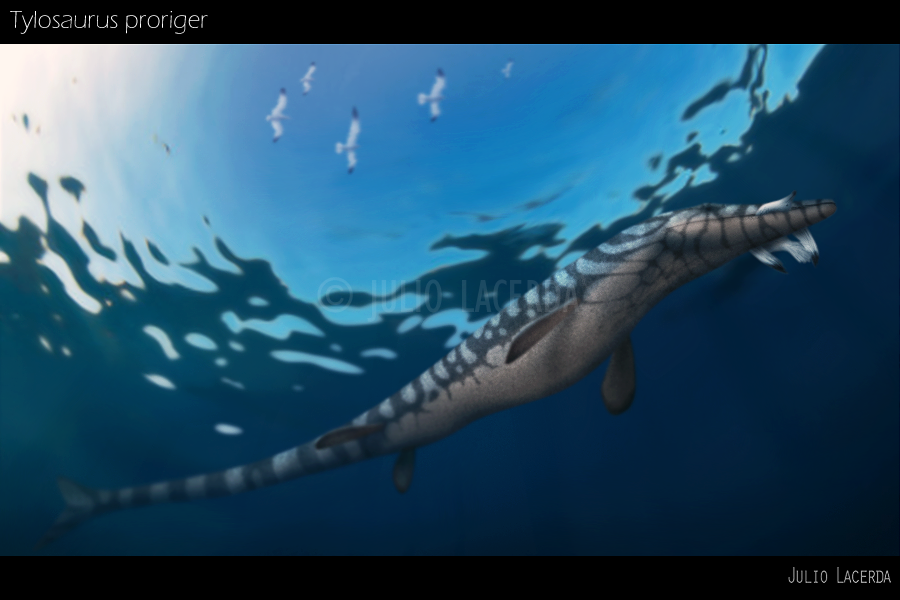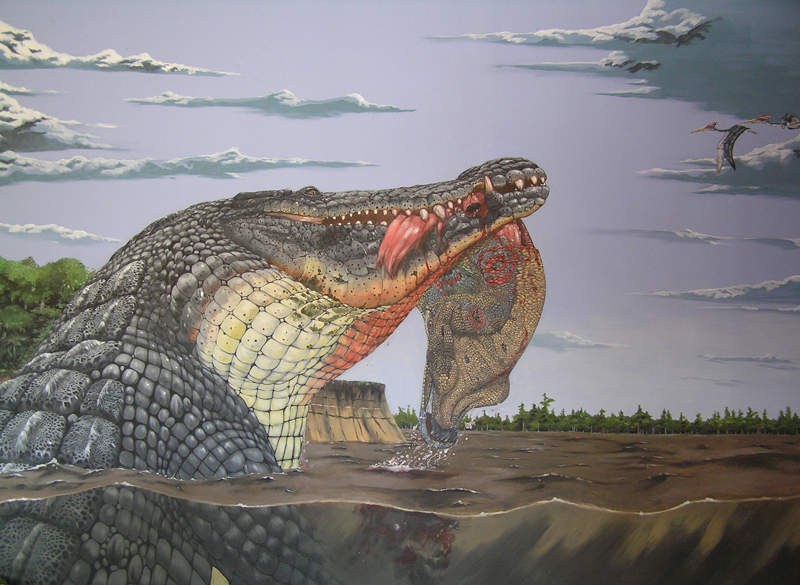Post by Infinity Blade on Feb 6, 2015 6:41:40 GMT 5
Tylosaurus proriger
Tylosaurus (Greek τυλος/tylos "protuberance, knob" + Greek σαυρος/sauros "lizard") was a mosasaur, a large, predatory marine lizard closely related to modern monitor lizards and to snakes. Tylosaurus (Greek τυλος/tylos "protuberance, knob" + Greek σαυρος/sauros "lizard") was a mosasaur, a large, predatory marine lizard closely related to modern monitor lizards and to snakes. Early restorations showing Tylosaurus with a dorsal crest were based on misidentified tracheal cartilage, but when the error was discovered, depicting mosasaurs with such crests was already a trend. Stomach contents associated with specimens of Tylosaurus proriger indicate that this ferocious mosasaur had a varied diet, including fish, sharks, smaller mosasaurs, plesiosaurs, and flightless diving birds such as Hesperornis. In some paleoenvironments, Tylosaurus seems to have preferred shallow, nearshore waters (as with the Eutaw Formation and Mooreville Chalk Formation of Alabama), while favoring deeper water farther out from shore in other environments (as with the Niobrara Chalk of the western U.S.). The Talkeetna Mountains Hadrosaur was a hadrosaurid of indeterminate classification whose carcass appeared to have been deposited in a bathyal or outer shelf environment that later became Alaska's Matanuska Formation. Every element of its skeleton not found in a concretion bore many closely spaced ovualar conical depressions ranging in diameter from 2.12 to 5.81 mm and 1.64 to 3.62 deep. These depressions are probably bite marks. The depressions are not symmetrical enough for gastropod drill marks and are not shaped like sponge borings. None of the preserved fish fossils of the Matanuska Formation fit the size or geometry of the borings. The size and spacing and shape by contrast, however, closely resembles the teeth of Tylosaurus proriger. The apparent tooth marks are unlikely to have occurred before the carcass was washed out to sea since that would have punctured the body, preventing the buildup of bloating gases that allowed the carcass to drift out to sea in the first place. The distribution of bite marks corresponds inversely to the presence of flesh in the animal. For instance, lower limb bones sustained the most damage because there was the least amount of flesh shielding the bones at those locations. The concretions formed as the flesh chemically reacted to the seafloor on the largest parts of the animal where the scavenging mosasaur would be unable to fully wrap its jaws around the carcass. Bones pulled free from the carcass were buried in the mud and preserved in mudstone.

© @ Julio-Lacerda
Deinosuchus riograndensis
Deinosuchus (/ˌdaɪnəˈsjuːkəs/ dy-nə-sew-kəs) is an extinct genusrelated to the alligator that lived 80 to 73 million years ago (Ma), during the late Cretaceous period. The name translates as "terrible crocodile" and is derived from the Greek deinos (δεινός), "terrible", and soukhos (σοῦχος), "crocodile". The first remains were discovered in North Carolina (United States) in the 1850s; the genus was named and described in 1909. Additional fragments were discovered in the 1940s and were later incorporated into an influential, though inaccurate, skull reconstruction at the American Museum of Natural History. Knowledge of Deinosuchus remains incomplete, but better cranial material found in recent years has expanded scientific understanding of this massive predator. Although Deinosuchus was far larger than any modern crocodile or alligator, with the largest adults measuring 10.6 m (35 ft) in total length, its overall appearance was fairly similar to its smaller relatives. It had large, robust teeth built for crushing, and its back was covered with thick hemispherical osteoderms. One study indicated Deinosuchus may have lived for up to 50 years, growing at a rate similar to that of modern crocodilians, but maintaining this growth over a much longer time. Deinosuchus fossils have been found in 10 US states, including Texas, Montana, and many along the East Coast. Fossils have also been found in northern Mexico. It lived on both sides of the Western Interior Seaway, and was an opportunistic apex predator in the coastal regions of eastern North America. Deinosuchusreached its largest size in its western habitat, but the eastern populations were far more abundant. Opinion remains divided as to whether these two populations represent separate species. Deinosuchus was probably capable of killing and eating large dinosaurs. It may have also fed upon sea turtles, fish, and other aquatic and terrestrial prey.

© @ dewlap
Tylosaurus (Greek τυλος/tylos "protuberance, knob" + Greek σαυρος/sauros "lizard") was a mosasaur, a large, predatory marine lizard closely related to modern monitor lizards and to snakes. Tylosaurus (Greek τυλος/tylos "protuberance, knob" + Greek σαυρος/sauros "lizard") was a mosasaur, a large, predatory marine lizard closely related to modern monitor lizards and to snakes. Early restorations showing Tylosaurus with a dorsal crest were based on misidentified tracheal cartilage, but when the error was discovered, depicting mosasaurs with such crests was already a trend. Stomach contents associated with specimens of Tylosaurus proriger indicate that this ferocious mosasaur had a varied diet, including fish, sharks, smaller mosasaurs, plesiosaurs, and flightless diving birds such as Hesperornis. In some paleoenvironments, Tylosaurus seems to have preferred shallow, nearshore waters (as with the Eutaw Formation and Mooreville Chalk Formation of Alabama), while favoring deeper water farther out from shore in other environments (as with the Niobrara Chalk of the western U.S.). The Talkeetna Mountains Hadrosaur was a hadrosaurid of indeterminate classification whose carcass appeared to have been deposited in a bathyal or outer shelf environment that later became Alaska's Matanuska Formation. Every element of its skeleton not found in a concretion bore many closely spaced ovualar conical depressions ranging in diameter from 2.12 to 5.81 mm and 1.64 to 3.62 deep. These depressions are probably bite marks. The depressions are not symmetrical enough for gastropod drill marks and are not shaped like sponge borings. None of the preserved fish fossils of the Matanuska Formation fit the size or geometry of the borings. The size and spacing and shape by contrast, however, closely resembles the teeth of Tylosaurus proriger. The apparent tooth marks are unlikely to have occurred before the carcass was washed out to sea since that would have punctured the body, preventing the buildup of bloating gases that allowed the carcass to drift out to sea in the first place. The distribution of bite marks corresponds inversely to the presence of flesh in the animal. For instance, lower limb bones sustained the most damage because there was the least amount of flesh shielding the bones at those locations. The concretions formed as the flesh chemically reacted to the seafloor on the largest parts of the animal where the scavenging mosasaur would be unable to fully wrap its jaws around the carcass. Bones pulled free from the carcass were buried in the mud and preserved in mudstone.

© @ Julio-Lacerda
Deinosuchus riograndensis
Deinosuchus (/ˌdaɪnəˈsjuːkəs/ dy-nə-sew-kəs) is an extinct genusrelated to the alligator that lived 80 to 73 million years ago (Ma), during the late Cretaceous period. The name translates as "terrible crocodile" and is derived from the Greek deinos (δεινός), "terrible", and soukhos (σοῦχος), "crocodile". The first remains were discovered in North Carolina (United States) in the 1850s; the genus was named and described in 1909. Additional fragments were discovered in the 1940s and were later incorporated into an influential, though inaccurate, skull reconstruction at the American Museum of Natural History. Knowledge of Deinosuchus remains incomplete, but better cranial material found in recent years has expanded scientific understanding of this massive predator. Although Deinosuchus was far larger than any modern crocodile or alligator, with the largest adults measuring 10.6 m (35 ft) in total length, its overall appearance was fairly similar to its smaller relatives. It had large, robust teeth built for crushing, and its back was covered with thick hemispherical osteoderms. One study indicated Deinosuchus may have lived for up to 50 years, growing at a rate similar to that of modern crocodilians, but maintaining this growth over a much longer time. Deinosuchus fossils have been found in 10 US states, including Texas, Montana, and many along the East Coast. Fossils have also been found in northern Mexico. It lived on both sides of the Western Interior Seaway, and was an opportunistic apex predator in the coastal regions of eastern North America. Deinosuchusreached its largest size in its western habitat, but the eastern populations were far more abundant. Opinion remains divided as to whether these two populations represent separate species. Deinosuchus was probably capable of killing and eating large dinosaurs. It may have also fed upon sea turtles, fish, and other aquatic and terrestrial prey.

© @ dewlap












